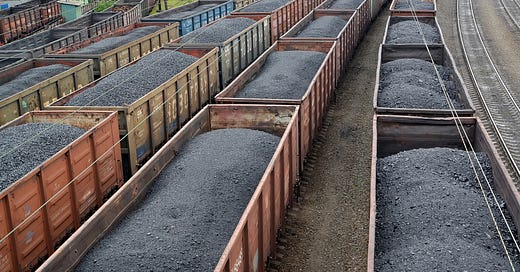Coal and industrialization
The dawn of industrialization in the 18th and 19th centuries was led by innovations in metallurgy, steam power, and production processes. The energy powering these developments was coal.
In pre-industrialized societies, biomass was the dominant source of energy including woody phytomass (firewood), crop residues, dry dung, and charcoal. These energy sources are renewable and limited by ecosystem constraints. Coal is a non-renewable, ancient biomass—a group of energy resources commonly called “fossil fuels”—that proved to be a more efficient power source than biomass in 18th and 19th century Britain—and subsequently all major economies of the world.
Coal is a black or brownish sedimentary rock formed when dead plant matter decays and is buried deep underground, subject to heat and pressure over millions of years. The best anthracite coals are nearly 100% carbon. Bituminous and lignite coals contain a number of impurities including sulfur, incombustible ash, moisture, and traces of heavy metals.
Both coal and wood biomass have similar energy densities. The energy density of coal ranges from 8 MJ/kg for lignites to 30 MJ/kg for anthracites. Coal and renewable biomass, however, have very different power densities measured by land area. Power density of biomass harvests range from just 0.1 W/m2 for woody species grown in arid and cold climates to 0.5 W/m2 the best crops harvest like corn (yielding 10 t/ha) and sugar cane (yielding above 50 t/ha). In contrast, even thin seams of coal can produce 1,000 W/m2 making it a vastly more efficient energy resource by land area. [1]
Coal is found in rock strata forming seams. In the 18th and 19th century, coal mining was energized by heavy human labor and the depletion of outcroppings in the 19th century drove miners to ever deeper seams. Deep mines required strong water pumps and ventilation, which were initially powered by waterwheels, windmills and horses until effective steam-powered pumps became available.
These were the energetic foundations of modern civilization: men with picks, shovels, and (later) simple jackhammers cutting coal from underground seams, often working in incredibly confining conditions narrow tunnels; women and children (and later also ponies harnessed to small wagons) moving the cut fuel to loading points; women (including teenage girls) ascending ladders with back loads of coal in baskets…; on the surface, horses (often with blinkers) walking in circle and turning the whims lifting coal (and miners) from deeper shafts. [1]
The two main industrial uses for coal in the 18th century were combustion in the steam engine and coke-fueled iron smelting. Demand from steam engines created a reinforcing feedback loop with engines increasing the demand for coal, which had to then be mined from deeper and deeper seams requiring more steam-powered pumps. Iron smelting is the process of melting iron ore—requiring a furnace capable of reaching over 1,500°C—allowing it to be cast into weapons, tools, cookware and other objects.
By the early 18th century, there were 60 charcoal-fueled blast furnaces operating in Britain, producing roughly 17,000 tons of pig iron and 12,000 tons forged into bars. The charcoal demands from these furnaces put immense pressure on regional forests and by 1700 nearly all accessible natural-growth forest was gone in Britain. With accessible coal seam outcroppings and a burgeoning mining industry, however, coal offered a seemingly limitless supply of fuel for British industrialization. [2]
In global terms, the 19th century was still dominated by biomass. In 1800 Britain was producing five times the amount of coal as continental Europe, and over the next 100 years all of the world’s major economies transitioned from biomass to coal making it the most important global fuel source of the early 20th century.
References
[1] Smil, V. (2016). Energy Transitions (2nd Ed.). Santa Barbara, CA: Praeger. Pg 73-74.
[2] Smil, V. (2017). Energy and Civilization. Cambridge, MA: The MIT Press.




